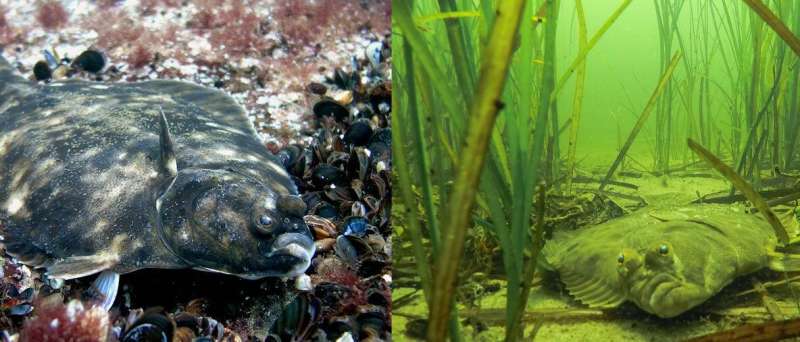Dramatic past declines of flounder verified and explained

Marine biologist Henri Jokinen investigated how and why flounder populations have decreased in Finnish waters over the past decades, and found that the story involves not one but two different flounder species, as well as environmental changes both at home and elsewhere.
Flounders, the iconic flatfishes of the northern Baltic Sea, were once very abundant before their drastic decline. At first, the reason for the decline was not understood. Resolving the mystery of the dwindling flounder populations involved the recognition that there were in fact two different flounder species, instead of only one.
"In the past, fishing nets were full of flounders, almost to the level of a nuisance for some. This is also seen from commercial fishery landings that plummeted over the past 40 years," says Henri Jokinen from the Marine Ecosystems Research Group at the University of Helsinki.
The decline of flounders on the Finnish coast was verified by using data that did not depend on figures from commercial catches. The results show clear downward trends over the last 2–4 decades. It was first believed that the decline on the Finnish coast was a local phenomenon with local causes.
However, genetics showed that instead of one population, flounders on the Finnish coast are a mix of two populations of different species; the European flounder (Platichthys flesus), and a new species, the Baltic flounder (Platichthys solemdali), a recently evolved species endemic to the Baltic Sea. This is interesting not only for taxonomists, but also because of the important differences between how the two species reproduce.
Differences in reproduction
The European flounder spawn eggs that develop in the midwater layer of deep offshore areas, whereas the newly described Baltic flounder spawn sinking eggs in shallower coastal waters. The decisive difference relates to salinity, which can be lower (>6 psu) for the Baltic flounder than for the European flounder (>11 psu). This means that only the Baltic flounder can reproduce along the shallow and less saline Finnish coast, while the closest spawning areas for the European flounder can be found in the deeper and saltier waters of the central Baltic Sea.
Notably, the proportions of the two species change over time. In the early 80s, the European flounder occurred in higher proportions in the Finnish flounder stock, and dominated in parts of the coast until they nearly disappeared during the 90s. The likely cause for this was the ceased import of European flounder larvae from the more southern spawning grounds. This was due to worsening water quality for pelagic reproduction in these far-away areas. Moreover, local environmental conditions affected the continued local decline on the southern coast of Finland. Based on model simulations, the local living conditions of the Baltic flounder seem to have been variable, but generally poor during the past 4–5 decades.
"We might not precisely know the past stock sizes, but now we understand much more about the dynamics and have a pretty good idea of why they need to sell Danish plaice smoked 'flounder' in the marketplace," says Jokinen.
Importance of a better understanding of Baltic Sea flatfishes and ecosystems
Understanding the implications of ecological adaptations might help to explain the observed population and ecosystem changes. A dominance shift between the two species described some of the observed decline, and both local and regional changes in environmental factors, including salinity, hypoxia, temperature and eutrophication, were identified as probable drivers. A combination of different descriptive/empirical, genetic and modeling approaches was used to achieve these findings.
The thesis has great value for how we understand and investigate stock dynamics of flounders in the changing environment of the Baltic Sea. The results will be important for future management and conservation of these fishes. There is also clear societal relevance, as the flounder decline has caused the demise of local fisheries of these popular flatfishes. Eutrophication and, more pressingly, climate effects such as rising water temperature and declining salinity are among the greatest problems in the Baltic Sea. Studying how populations persist and change will help us to understand the system-wide ecological upheaval happening in the Baltic Sea.
More information: Population dynamics of flounders in the northern Baltic Sea—declines, cryptic species andenvironmental drivers. helda.helsinki.fi/handle/10138/31454
Provided by University of Helsinki


















